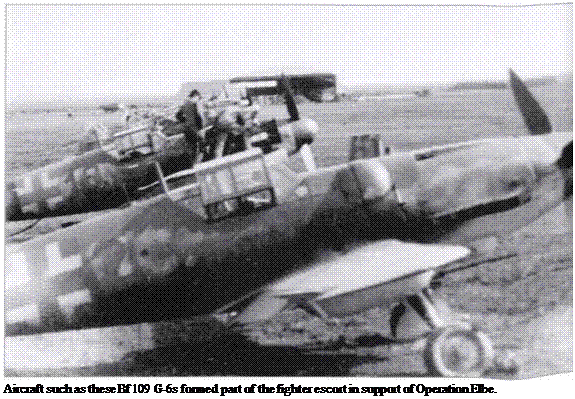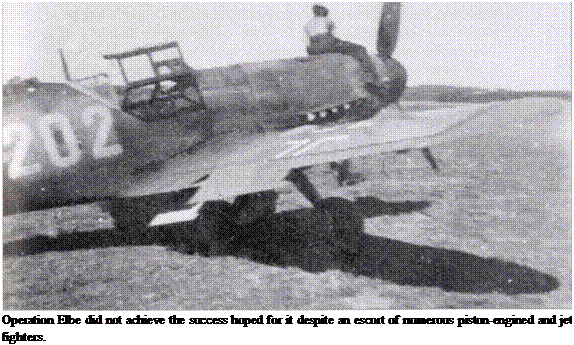Desperate Operations of the Ram-Fighters
The Rammjager went one step further. The idea was that, should the enemy aircraft attacked not be mortally wounded by gun fire, it was to be finished off by ramming. The loss of air superiority goaded a small group at OKL into taking these drastic measures. For some time the tactic was rejected by many unit commanders, and also by some pilots asked to undertake it. General der Jagd – flieger Adolf Galland opposed it and was relieved of office on 23 January 1945 by Goring, his replacement being the more committed Oberst Gordon Gollob. At the same time Goring appealed to all fighter pilots ‘inspired by holy fire, being conscious of the struggle for a just cause, to give everything’.

Galland had favoured conventional fighter tactics, if possible from a numerically superior position. As a means of downing whole bomber formations, he wanted to send up a thousand fighters at a time. For this reason in the autumn
3

of 1944 he had tried to re-equip and re-staff the exhausted fighter units. On 18 November 1944 he accumulated 18 fighter Geschwader and 3,700 pilots for ‘The Big Blow’, but despite long preparations the concentrated attack never came, so strong by then were the Allied air raids and their penetration to the heardand of the Reich.
This was therefore the prevailing sorry state of affairs from which Oberst Hajo Hermann revived his idea of the mass ramming operation. Even Hider, despite all his reservations, approved the concept, ‘if unwillingly’, as his Luftwaffe adjutant Oberst von Below reported later. When Oberst Hermann seized the opportunity to make his proposal at the Reich Chancellery in January 1945, Hider replied that he would not order it, but nor would he stand in the way of those who wanted to volunteer for it.
Rammkommando Elbe was set up at the beginning of March, with control being placed in Gollob’s hands. The first volunteers were assembled at Stendal aerodrome and lodged in an enclosure with a double security perimeter. At the end of the month, about a week before the start of the ramming operations, Anglo-American land forces were already at Gotha, Kassel and Munster, and approaching Erfurt, Halle, Hannover and Wurzburg. In the East the Red Army
was preparing for the final assault on Berlin. Nevertheless on 31 March Oberst Hermann called on his pilots ‘to fight to the uttermost’. His vision was that Ramming Unit Werwolf s pilots would destroy coundess Allied bombers at the selfless expenditure of their own lives, to such affect that the USAF would be forced to break off its bombing operations. This was obviously an illusion.
The training course at Stendal was basically theoretical for shortage of fuel. The pilots were kept in good humour with plentiful meals, cognac and chocolate which, unlike the fuel, seemed available in unlimited quantities. There was also a shortage of unit commanders with front-line experience since these knew only too well what this kind of operation would demand of them. Therefore they were commandeered from the ranks of IX. Flieger-Division( J) to build the framework for the young pilots who had volunteered for ramming operations in the hoped – for numbers.
On the night of 5 April 1945,30 pilots were driven from Stendal to Delitzsch, Eilenburg, Gardelegen, Sachau, Salzwedel and Stolpe. For psychological reasons OKL did not want to delay the operations too long and had set 7 April as the opening date. Many of the pilots had too little experience with the Bf 109. Fighter protection was to be Me 262s of Stab and III./fG 7 from Brandenburg- Briest. The ramming aircraft were to assemble over Magdeburg and climb to 11,000 metres (36,000 ft). Spurred on by heroic words and military marches they would receive the order to attack – ‘To all vultures and falcons – attack at will! Sieg Heilfln all 184 Bf 109 ram-fighters and 51 Me 262 escorts, of which 48 eventually took off, were to be deployed. The tactical inexperience of the attackers resulted in the mission of Sonderkommando Elbe not proceeding as hoped. The Eighth AF bomber formations were at 7,000 metres (23,000 ft) altitude and their fighter escort was quickly in attendance. The Bf 109s were only able to engage singly or in small groups, and the bomber losses remained within acceptable limits.
At the end of the engagement, 77 mosdy young pilots had been shot down. The Luftwaffe had lost 133 machines, numerous others were damaged to a greater or lesser degree by enemy defensive fire, and many of these crash-landed. On the plus side 23 heavy bombers, most attached to 3rd Air Division, were destroyed by ramming or the Me 262s of JG 7. Others got back to England, tailplanes ribboned, wings damaged. Overall the long-planned operation had not brought OKL the desired result.
Nevertheless Oberst Hermann would not give in. He wanted better preparations for a second try; next time the 80 remaining pilots of Sonderkommando Elbe would attack the bomber formations over their bases. But time ran out. Apart from individual instances of ramming Allied aircraft, towards the end there were some sporadic suicide missions on the pilot s own initiative by those who realised that the war was lost and did not wish to survive it.










